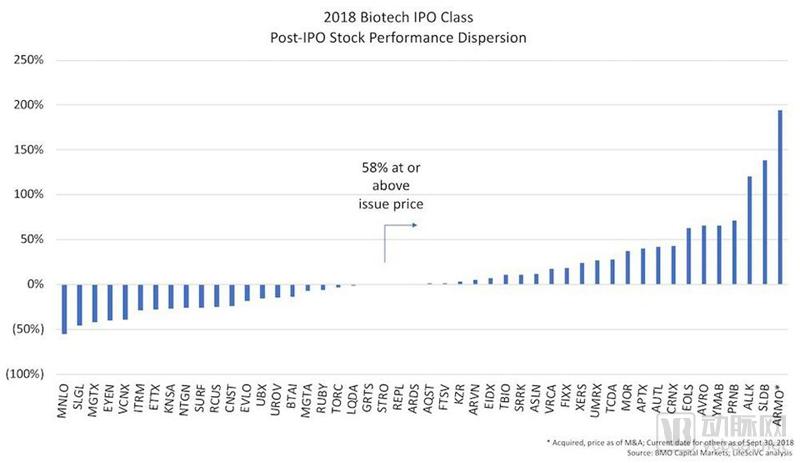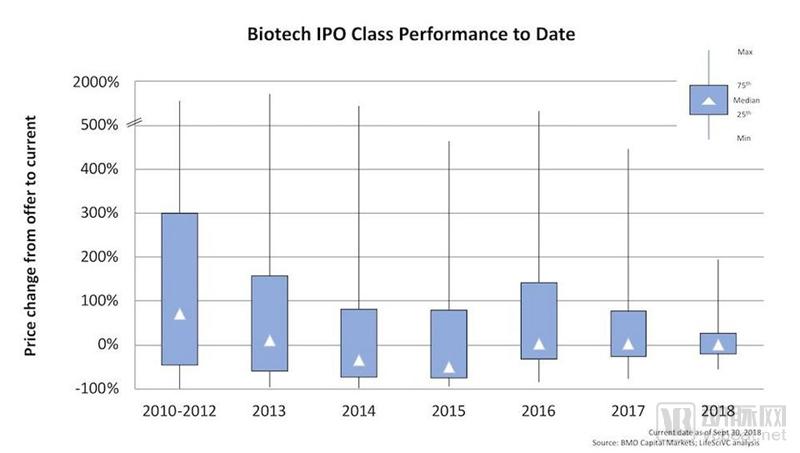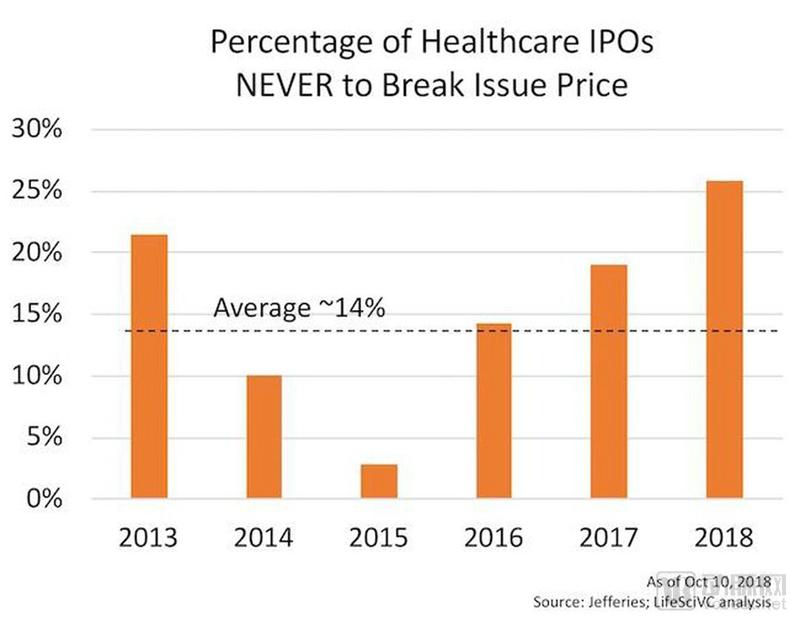Recently, Forbes published an article entitled "The 2018 Biotechnology IPO boom from the aftermarket." The article shows that the biotechnology company IPO in 2018 is extremely hot.
Compile:
In the first three quarters of 2018, biotech companies issued nearly 50 new products, consolidating strong performance in the past six years. Because many authoritative sources worry about overheating in the market, or over-emphasize negative factors when the market is in a downturn, it is worth considering how the stock performance after the IPO this year matches the data of previous years.
Leerink's Geoffrey Porges recently published a valuable report focusing on the entire IPO window and the return on new biotech products during 2013-2018. As expected: Measuring the median of the performance distribution is not attractive, but about 20% still account for most of the stock price and valuation gains, which happens to reflect the 28th law.
Based on some IPO share price performance data from BMO (Montreal Bank Capital Markets), the following is the dispersion of 48 biotech IPOs listed on September 30, 2018. As is evident from the chart, the share price of most companies (58%) has reached or exceeded the IPO price. Some big companies have already paid off handsomely, such as ARMO, Solid Biosciences and Allakos. Of course, bad data can quickly destroy a stock (such as Menlo).

Decentralized performance after IPO
Comparing this performance distribution with the previous annual IPO Corps, it can be seen that many of them have longer time to sell in the market, as expected: the highest and lowest stock prices as market time increases The performance is more dispersed (including the 75th and 25th percentiles).
Since 2010, the median price of the entire IPO Corps has changed to -2.9%, but the average is 69%, which is the ratio obtained under the influence of large outliers. In 2015, the NASDAQ Biotech Index hit a record high in July, but its performance remained the worst, with a median return of -50% to date. Although in the past three years, the first quarter has achieved more than 80% growth.

The performance of biotechnology in the stock market after IPO
Another way to disperse market performance after observation is how much of the IPO category is still higher than its initial offer. Historically, this range is typically 40%-60% at any given point in time after the IPO. For example, as of October 2007, 41% of biotech IPOs were higher than their issue prices between 2003 and 2007 in the market peaks of the previous decade; the situation during the financial crisis was even worse, so by 2009 6 In the month, only 21% of the company's stock price was higher than its issue price. Of course, this situation has improved in recent years.
This is the IPO window breakdown for the most recent year ending September 30. In 2018, 58% of the IPO category was higher than its IPO price. In 2014 and 2015, it was less than 40%. Given the volatility of the past two weeks, these ratios may fall slightly in mid-October.

Percentage of companies whose share price is higher than their IPO price as of September 30, 2018
But volatility is a unique feature of biotechnology, and it does not disappear. Our transactions are event driven and data can have a huge impact on it. Even in the absence of data, market sentiment will change. Over time, stock prices are often weakened if there is no reliable message flow. Its liquidity is very tight, and small changes in stock trading often lead to large changes in stock prices.
To capture the volatility of the post-marketing company, Jefferies' Matthew Kim asked his team to conduct an interesting analysis: How many IPOs have never broken their initial offer? According to the analysis of Jefferies, since 2013, only 14% of healthcare companies never had a problem. The same applies to biotech IPOs. Even big companies like Agios and Juno will give up their quotes at some point after the IPO. Given the impact of market timing and volatility, there are more IPO bankruptcies in 2015 that make sense. In general, the recent IPO ratio of a number of listed companies is higher.

Biotechnology IPO "forever" will not break its issue price
It is obvious that 2013-2018 is the most active IPO period in the history of biotechnology. A rarely mentioned metric is the consistency of IPOs on the market. In most years before the advent of biotechnology, there was no IPO activity for a long time. Since the current IPO window was officially opened in March 2013, 66 months have passed.
According to BMO data, we did not witness an IPO during the four months from December to January 2016 and February to March 2017. In the remaining 62 months, all companies have conducted at least one biotech IPO, with an average of more than once a week, which lasted nearly six years.
The trend of stock price volatility and decentralization after IPO should focus on the following topics:
1. Starting from the initial public offering, we expect that 40%-60% of IPOs will be traded at a price lower than the issue price, especially if the market is adequately adjusted;
2. The initial public offering of most biotech companies will break the issue limit and fall below the issue price at some point during the development of the drug;
3. Less than 20% of the products will continue to drive the market returns of most companies after the initial public offering;
4. Given the continuing level of IPO activity, we may have entered a stage where companies with trusted treatment products can be listed in virtually any macro context.
In short, these and other data show that our capital markets are much more mature and resilient than the environment in which biotechnology was first used.
endotracheal tube,ett tube,tracheal tube,intubation tube
2 MEDS TECHONOLOGY CO.,LTD , https://www.2-meds.com